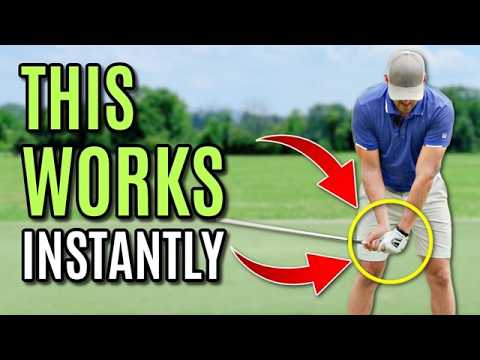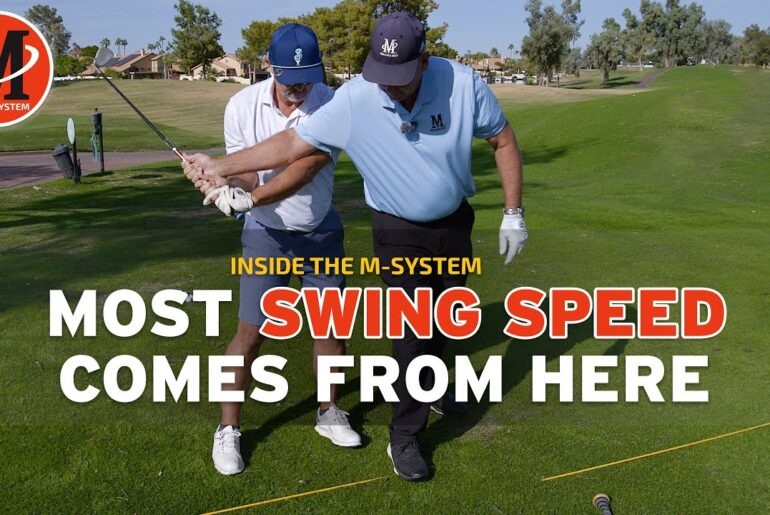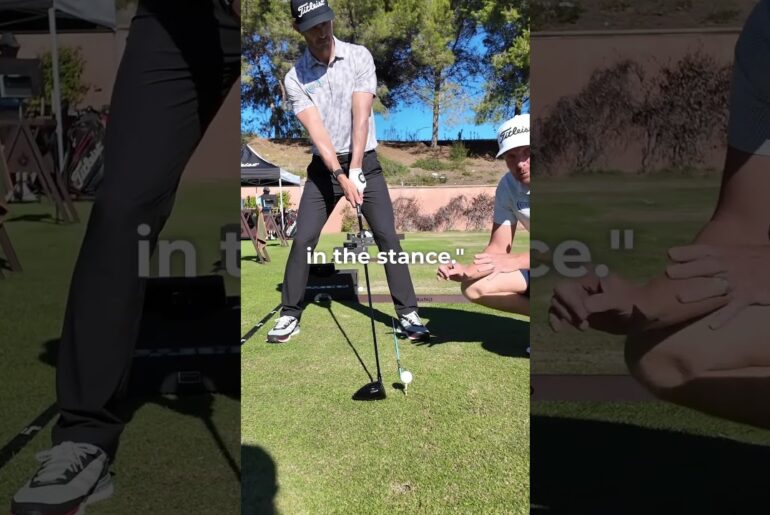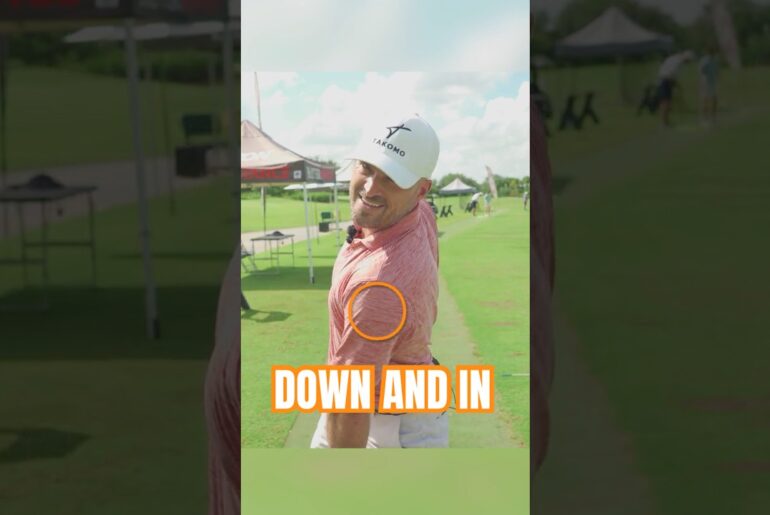Eric Cogorno and Giles Gill explain why wrist hinge is the cornerstone of a quality golf swing. They teach how and when to hinge your wrists in your golf swing to control the clubface and unlock consistent ball striking that PGA Tour pros use every round.
⏱️ 0:00 – Why wrist hinge is critical for controlling the golf club, generating power, accuracy, and consistency.
⏱️ 0:58 – How to hinge the wrist
🔍 1:47 – The speed and compression benefits of proper wrist hinge in golf swing
💪 3:15 – Left hand push technique to create wrist hinge
⚙️ 5:25 – Right hand pull technique to create wrist hinge
🎯 6:48 – Timing checkpoints used by PGA Tour professionals
✅ 8:48 – Isolated wrist hinge drills for each hand
🏆 12:30 – Flow drill to integrate wrist hinge in golf swing naturally
This comprehensive golf swing lesson reveals why wrist hinge is the foundation of consistent ball striking. Learn the push-pull mechanism that PGA Tour professionals use to control the clubface, create lag, and generate effortless power.
What You’ll Learn:
• Why wrist hinge is crucial for controlling the golf club and swing consistency
• The push-pull mechanism: left hand pushes down, right hand pulls back
• How to hinge the wrist with proper timing checkpoints from PGA Tour pros.
• Left hand technique for creating width and promoting chest rotation
• Right hand wrist set that flattens the lead wrist automatically
• Timing guidelines: shaft parallel to ground when hands golf reach mid-thigh
• 90-degree checkpoint position for optimal wrist hinge in golf swing
• Individual hand drills to develop proper wrist hinge feel
• Flow drill technique for integrating wrist hinge into your natural swing
• How wrist hinge connects to overall body rotation and swing sequence
• Why different PGA Tour players vary hinge amounts but follow same principles
• Practice methods to control the clubface
#wristhinge #golfswing #handsgolf #controltheclubface #pgaTour #howtohingethewrist #wristhingeingolfswing #golfinstruction #golflessons #golftips
**You can find our friend Giles Gill on YouTube at @gilesgillgolf and for more information, visit https://www.gilesgillgolf.com
______________________________________________________________________
MY BEST STEP-BY-STEP GOLF TRAINING PROGRAMS HERE: https://ericcogornogolf.podia.com
Check out our awesome partners and the products I personally recommend + DISCOUNT CODES:
Takomo Golf – https://takomogolf.com
Shot Scope – https://shotscope.com/?rfsn=7840102.d3a7ba&utm_source=ericcogorno – Use Code COGORNO for 15% off
L.A.B. Golf – https://labgolf.com – Use Code COGORNO for 10% OFF
LiveView Sports – https://liveviewsports.com/pages/ECGolf – Use Code ECGOLF for $40 OFF
Precision Impact Right Wrist Trainer – https://pureswingproducts.com/?sca_ref=1815522.bXQUsGp2bS – Use Code COGORNO for $20 OFF
theHanger Training Aid – https://www.hangergolf.com/?sca_ref=944104.HqM9GYcX2I – Use Code COGORNO to get 15% off!
______________________________________________________________
**I may earn a small commission for my endorsement, recommendation, testimonial, and/or link to any products or services recommended on Eric Cogorno Golf sites. Your purchase helps support my work in bringing you free content to help you learn about golf and improve your game. My goal is to help people through my experience so I will not recommend a product or service unless I’ve
1) Used it personally. (which will be the case the vast majority of the time)
2) Thoroughly researched it and got first-hand user feedback from other professionals I trust and who have used the product/service.
Your arms and hands are literally the only connection to the golf club. If you don’t get this part right in the swing, you’re never going to have the consistent, reliable golf swing that you want. If you’re a golfer who struggles with rolling the club face open, maybe you’re super scoopy or flippy at impact. Perhaps you got a super wide swing with no speed or power. Or even if you’re losing the club at the top of your swing, this video is for you. Okay, Mr. Giles is back with us here today. Giles, appreciate you being here. Thank you for having me back, Eric. Thank you. If you haven’t seen Giles videos, awesome channel. We’ll link that down below. Wrist hinge. So, question number one in part number one is why do we have to hinge our wrist in the golf club in the swing? Well, like you said, it’s the only connection we have to the golf club. If we get this wrong, we’re never going to be able to control the golf club. So, first things first, assuming we’ve got a decent grip, if we can control our wrist hinge, we’re going to be able to control the club face. The club face sends it. If you want to send the ball in the correct direction, you got to learn to control this. But the club face also has a huge influence on the rest of your swing. So, the plane that we take this club on, if we take it too far out, too far in, we’ve got to make sure we can set the club up onto a beautiful plane. We can control the face because from there, it’s going to promote a down swing that’s a lot more on plane. We’re going to be able to create lag. We’re also going to generate more shaftling, more compression, a ball then ground contact, more rotation on the way through. The list is honestly endless when it comes to this. So, if you want to learn to strike a golf ball somewhat consistently, it starts with the wrist. There are obviously other things, but it starts with how we move our wrists. You know, Giles, the other thing I like as a simple version in terms of hinging the wrist. Obviously, we hinge the wrist up vertically. You know, that’s the piece that makes the club go up. And what goes up we know must come down. We’ve got an iron with a ball on the ground that we need to get off the ground. And so part of the reason we need to hinge the club outside of all the benefits we just mentioned is just to get the club to work up and down enough to hit the ball. And obviously the hinging is a speed producer, right? The hinging up and down creates a lever that’s a speed producer. So hit the ball, take a divot, hit it high enough and far enough with enough spin. The bad version, let’s say, would be like no hinge whatsoever. We’ll just call that bad for the moment. One of the bads. So, if I had no hinging on either side of the swing, it’s hard to hit the ball far enough and creating height. Here’ be my no hinge swing. So, I didn’t hinge the club on either side of the swing. And even if I try and go as fast as I can with like my body motions, it’s still hard to produce a ball where I get good compression and hit the ball far enough. Here’s no hinging at all. So that’s a eight iron that I probably hit I don’t know 100 110 20 yards. If I create the same sort of energy or swing speed but I create the vertical hinging on both sides that ball probably traveled with a smooth swing maybe 150. Mhm. So speed production be able to compress the ball. The hinging is super important of course and it’s like you say it’s crucial for strike. It’s crucial for speed. is crucial for club face control and that shot there proves it. Now, there’s different ways to learn how to hinge. Obviously, I really like the way Giles explains this. Whether you’re left side dominant or right side dominant, you can feel it with either hand, but understanding what each hand is responsible for makes this a lot easier. And later on in the video, we’ll give you a simple way to put this into your normal swing. Let’s talk some details first. In terms of the left hand, Giles, what do we want to feel and how do we do it? I think the easiest way to view wrist set is it’s a pushpull mechanism. So there are two things going on here and they’re opposing and this is what allows us to set the club up. So the lead hand, my left hand in this situation, if I was just to grip it and take the bottom three fingers off and just have my index finger and heel pad on and just hook just one of my fingers on my right hand on, if I go and push that heel pad down, my toe line, you can see how it starts to set that club up. And actually, you can see there from the downline view how it’s gotten that club face in a really nice tilted position, which therefore is going to allow you to come back with some shaftling. So the left hand really for me, if I was to place my club on the ground, place my right hand behind my back and have it down here, I feel like I’m pushing my left hand down. Now Eric, if you take a look at my left arm, you can see I’ve got beautiful width right there, but what’s happening with my shoulder? Yeah, you can see Yeah, it gets that down motion. Now you look at stack and tilt. You look at a lot of the mo the coaching systems out there, the tour pros, you won’t see those golfers go this way. If you take the club back and you see this motion, you’re going to take that club inside every single time. It’s going to be super hard to control. And so, as you’re doing that left hand down motion, Giles, I think one of the important pieces like it’s not just down at the ball, it’s like down and back. Yeah. If I go just down at the ball, then I’m just setting that club up, right? And also, this is where the left shoulder comes in. We don’t want to see the left shoulder just go straight down because otherwise we’re going to get stuck on the left side. We’re going to be losing loads of height. So everything blends really nicely together and pushing down across my toe line just like so. As if I’m pushing that palm down that club. And if you see that there, that promotes chest rotation. It promotes getting the club in a great position, the left shoulder a great position, the left arm great position. Place my right arm on. It’s also created that natural fold in that trail arm right there. Okay, Josh. How about the right wrist and the pull action? So, like I said, it’s a push pull motion. So, if you imagine we’re pushing with the left hand, well, the right hand’s got to do the opposite, right? So, we need to pull this right wrist back. Now, the feeling I love is taking the knuckles and just bringing them back to the forearm. If I have my hand up in front of me here, I’m holding a tray. And you would have heard that analogy, you know, at the top of your back swing, you want to feel like you’re holding a tray above your trail arm. Well, essentially it is just setting that right wrist back on itself. Now, you can see when I do that, it actually forces the club to go into an excessively closed position right there to where the face is pointing really, really far down to the ground. So, this is then when we blend the two motions together, we get sort of this 45° wrist set that gets that club a little bit face down to the ground matching spine angle. And then from there, if I add my chest rotation, it comes to a perfect position right there. So, it’s push pull. I’m pushing down the toe line and pulling back with the right wrist. If you blend those two motions together, you’re going to have beautiful width, club face control, club’s going to sit up on plane, it’s going to go up, it’s speed, it’s the list is endless. So, we talked about the how, now the when part. Yeah, Giles. So, for those of you that like the details, couple easy checkpoints here. As we’re pushing down with the left, pulling back with the right, you’ll see players like Nelly Corda, Adam Scott, many other great players. How much hinge should I have by what point? By the time the hands, the butt of the club get just outside the trail thigh and the hands are even with the middle of the trail leg, that’s about when the shaft should be parallel to the ground. That would define how much you have by what time. Obviously, Giles, if I went back and the club didn’t get parallel to the ground until my hands were like hip high, that would be relative to our a neutral model, right? This would be theoretically not enough soon enough. If I got to parallel to the ground before my hands even moved back, that would be theoretically too much too soon. And look, you don’t have to be perfectly here. We’re just using this as like a a guide. A guide. It’s a guide. Now, if I get from here, the next checkpoint I would look for, and we’ll use Nelly and Adam Scott and many others, you want to get roughly 90 degreesish with the shaft and the arm, about 100, right? A little bit wider than 90 to the 90 is like a pretty good spot, especially with an iron. Yeah. Right. With the driver, you might be a little bit wider, but with an iron, you’ll see that both those players about here. This is the point in the swing where you create that 90 degreeish angle. from the down the line the shaft angle the butt of the club would point like roughly at the ball line the ball target line from here and this would be where my lead wrist would be like flattish right so my right wrist is bent back maybe that 45°ree sort of angle we’re feeling flattish with the left wrist so as you’re pushing down with the left pulling back with the right in motion as my body is moving right those are some checkpoints where I can ensure that I’m doing the right amount at the right time. How I like to initially learn this, I want you to try this with me. Take the club with your left hand only. And we’re going to do three reps where we just feel the left hand doing the pushing uh down and away. So, just the left hand only to create some of that hinging, right? To feel that. And when I’m doing the exaggeration here, notice I’m going to actually hinge the club a little bit more than those checkpoints because I’m trying to exaggerate a bit. I’m trying to feel some early hinging. Couple rehearsals with just the left hand. I like to then do a couple with just the right hand. Now I’m feeling the pulling back, right? The right wrist knuckles getting to the forearm like Giles mentioned. A couple feels to feel that. I’ve had a lot of success teaching students feel it a little bit with just the left, feel a little bit with just the right. See which one you queue in on better. And then let’s feel that together, right? To get that sensation of the left wrist pushing down, the right wrist back. And and if you need more hinge, a nice feel, even though it’s not our exact checkpoint, is about here when the hands are about hip high and the shaft’s probably just shy of like 90. It’s probably 100°. So, it’s a little overexaggerated, but it’s a good way to feel that, right? Initially, 100%. So, I did three with the left, three with the right. Now, I’m going to feel that in my normal stock swing. That was nice. Charles, couple quick points on the wrist hinge before we show them that drill. They could flow it into their normal swing. Yeah, of course. So, I know a lot of questions will get fired at this. So, let’s just sort of run through. Now, you will see a golfer like Danny Willlet. He will have a lot more wrist set. You will see Xander Schoffway, he’ll have a lot less. The key thing is they are just moving their wrist at different amounts that feel better to them. They are still following the pushpull mechanism. Some are doing it more than others. Some are doing it earlier than others. That’s personalized down to you. So, we’re showing you how to move the wrist. You can put your thumb print on it. The next thing is when we are physically pushing with the left hand, I like to imagine it’s the heel pad right here. Hence why I said assuming a good grip, if we get that heel pad on top, it’s going to be the heel pad that’s pushing down on the top part of the grip that creates that setup. Another question I get asked all the time is, Charles, well, how do I get that left wrist flat? Well, a lot of golfers will then try and focus on the actual left wrist and you’ll see sort of bowing and it’s very very uncomfortable for a lot of people versus if I simply just pull that right wrist back. You can see if I do this on the camera, I’ve got a little bit of wrist set right there. If I pull that right wrist back, it flattens the wrist off. Yeah, you don’t have to manually manipulate the left wrist. If you simply get that right wrist setting back, it is going to pull that left wrist into a good position. Hence why when we go to the top, we can see like that left wrist is nice and flat right there. Tiny. And the final question I often get asked is, well, what about the chest rotation? How does that piece blend in? Well, if I’m working this correctly, especially with the left hand, if I’m pushing that away, my chest is going to turn automatically. Everything’s connected right here. It’s a sequence. It’s a chain reaction. So, if we get this club moving on a good plane on the way back, we’re feeling that pushpull. everything else, the width element, the right arm folding, swinging back on plane, the chest rotation, the hip rotation, it’ll all just get pulled along into the correct position. So, it takes care of a lot of things. It’s sort of one swing thought, one concept to fix five, six, seven different other things. So, in terms of practicing this, obviously you can do the left wrist only, right wrist only combo drill that I showed you. But Giles, if someone didn’t want the details, they wanted more of like a simple way to flow that into the swing, how would someone do that? Well, I think the first thing is when we are doing this exercise, we’re learning the position we’re trying to get to. So, we’re learning how does the right wrist feel, how does left wrist feel, but to get that rhythm, that sort of freedom to the swing. I love to do a little swing where I start with the club head past the ball and just get it swinging back with some momentum. When we have the weight of the club there, it’s going to help us get that little upward set. As long as we know the little function of how the wrists are working. If you do that here for me, you’ll naturally see, you know, the position you’re trying to get to. If you add that flow in, you start to get that rhythm, the club sets up, and actually you’ll feel like you can get way more speed, like a like a whip in a sense if you get that rhythm, you’re relaxed, you can really fire the speed into the club head, which is the thing that matters. I also like if you guys are doing this and you notice because you’re focusing on your wrists that you tend to get really tight and like it’s like a lot of tension there. This is a nice way where I can like loosen up my grip pressure and my arms a little bit. Still feel the pushing back, pushing down, pulling right to your point. It’s a really nice way to start to feel that just to get a little flow going with that. Then if I can hit one Giles, feeling that same like I’m flowing into that same sort of position as I go back. Yeah, that was crushed. Beautiful. All right, guys. So, getting the wrist hinge in the golf swing. So darn important. Different ways to do it, but that’s a nice stock model. Pushing down with the lead hand, pulling back with the right hand at the end. That little flow drill really feels nice. I would highly encourage you to give that a try as you’re doing it. Mr. Giles, if you haven’t checked out his channel, we’ll link that down below. Great YouTube channel. He does online lessons, golf schools in person. You’ll love those. Go check them out. If you guys have any questions, as always, leave us a comment down below. If you enjoyed the video, consider liking, sending to a friend. Thank you for watching. If you like that and you want to see more on wrist hinge, watch this one next.








13 Comments
Great video Eric… Does this apply to driver as well?
Luckily I have good power. I have very little wrist hinge. Something I need to add for sure.
Incredible lesson here. Thank you
Love the level of detail here as well as the different ways to train it. Excellent video thanks 👍
Learning the wrist hinge was such a game changer for me in my golf swing, it also totally influences the top of the seing. I can’t stress how important it is to have a neutral grip though because all of this hinging can completely open or overly shut the face in the takeaway if your grip isn’t in a good place
Excellent video on setting of wrist, but how about some discussion of the downswing thoughts with the wrists through impact?
This was an excellent lesson. I like at easy drill you demonstrated at the end of the video.. one can incorporate that into their pre shot routine.
Another great video Eric. Thanks a million.
Thanks for adding more shot tracers. Makes a big difference.
2 powerful coaches, the way they teach is nice. You 2 help me to improve my golf. Thanks nice video.
No question the correct wrist hinge keeps the swing on plane, and produces lag and speed in the downswing. I find that turning the shoulders and core and feeling the weight of the club in my hands produces the momentum for a good hinge and back swing. I found too much emphasis on the wrists and hands produces tension.
Sure it does
Does your reoccurring thought of what you do going back you have to region the way down?
Meaning, I pull with the left and push with my right hand/wrist on the way down?